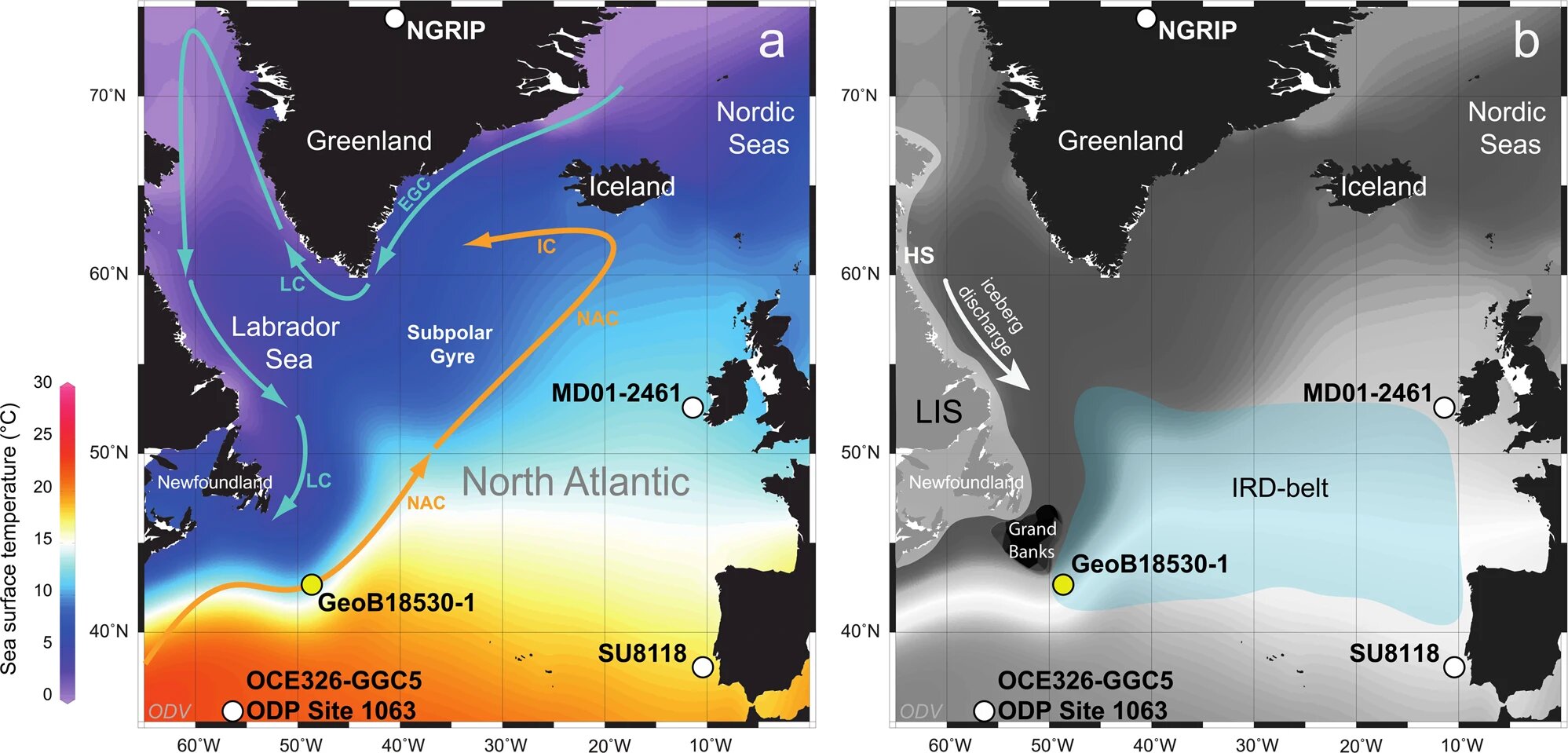The Atlantic Meridional Overturning Circulation (AMOC), a system of ocean currents that transport warm water from the tropics to the North Atlantic and cool water from the Northern to Southern Hemispheres, is a fundamental mechanism for regulating Earth’s climate. The conveyor belt has collapsed in the past due to natural factors. The recent collapse played a key role in the last deglaciation. AMOC is now threatened by global warming, scientists have shown, and a new study has uncovered the sequence of past collapse events.
The study was conducted by German researchers and Brazilian paleoclimatologist Cristiano Mazur Chiessi, professor at the School of Arts, Sciences and Humanities (EACH-USP) at the University of São Paulo in Brazil. An article reporting their findings is published in nature communication.
“A study of marine sediments collected between Canada and Greenland led to the discovery that in the past, glaciers covering the areas now corresponding to Canada and the northern United States produced a colossal number of icebergs due to warming of the sea surface into the Atlantic region,” Chiessi told Agência FAPESP.
The icebergs melted in the ocean and deposited continental sediment on the sea floor. “Identifying these sediments and reconstructing the subsurface temperature in the region allowed scientists to determine for the first time that subsurface warming preceded the mass release of icebergs,” he said.
The enormous amount of freshwater added by the melting of the icebergs changed the composition of the ocean at high latitudes in the northern hemisphere. This had a huge impact on global climate, as the region between Canada and Greenland is a particularly sensitive part of AMOC.
“This gigantic conveyor belt transports lighter, warmer surface water from the South Atlantic to the North Atlantic. At high latitudes in the North Atlantic, this surface water gives off heat to the cold atmosphere, becomes heavier, and sinks down the water column. The deeper, colder, and denser water then flows south again until it reaches near Antarctica, where it returns to the surface through strong upwelling. At the surface it warms up, loses density and completes the circulation,” Chiessi said.
AMOC not only transports a huge amount of water of around 18 million cubic meters per second. It also transports an enormous amount of energy, equivalent to about 100,000 times the energy produced by Itaipu, the world’s second-largest hydroelectric power station, on the Brazil-Paraguay border. The spatial distribution of this energy affects the climate in several parts of the world, including Brazil. Vigorous circulation sustains the climate as we know it, while its collapse causes a marked redistribution of energy and alters the climate.
AMOC collapsed several times during the last ice age between about 71,000 and 12,000 years before present (BP). Other studies led by Chiessi, based on an analysis of marine sediments collected between the coast of Venezuela and northeastern Brazil, showed that these collapses caused a torrential increase in rainfall in northeastern Brazil and a sharp decrease in rainfall in Venezuela and extreme northern Amazonia caused . Declining rainfall has also been reported in tropical areas of North Africa and Asia.
By discovering that high-latitude subsurface warming of the North Atlantic preceded the massive release of icebergs from Canada and the US into the Atlantic, researchers were able to determine the sequence of events responsible for the AMOC collapse.
“The process begins with a seemingly insignificant weakening of the AMOC, leading to subsurface warming at high latitudes in the North Atlantic. This warming is melting the soles of glaciers, rapidly moving glaciers seaward and releasing colossal armadas of icebergs. As the icebergs melt, surface water salinity decreases in the region. The surface water is not dense enough to sink and AMOC is collapsing,” Chiessi said.
Monitoring of the AMOC over the last few decades shows that it is weakening. There are three main reasons for this: intensification of precipitation at high latitudes in the North Atlantic; melting of the ice cap over Greenland; and warming of the planet’s surface. All three causes are linked to the increase in greenhouse gases in the atmosphere due to human activities.
This latest discovery suggests that the weaker AMOC will cause anomalous high-latitude subsurface heating in the North Atlantic, which will melt glacial soles in Greenland. Ultimately, this could lead to the collapse of AMOC and exacerbate the climate crisis with significant repercussions.
Deep-sea warming due to climate change
Lars Max et al., Subsurface Ocean Warming preceded Heinrich Events, nature communication (2022). DOI: 10.1038/s41467-022-31754-x
Citation: Scientists Discover Mechanism That May Cause Collapse of Great Atlantic Circulatory System (2022 October 18) Retrieved October 18, 2022 from https://phys.org/news/2022-10-scientists-mechanism-collapse-great -atlantic.html
This document is protected by copyright. Except for fair trade for the purpose of private study or research, no part may be reproduced without written permission. The content is for informational purposes only.
#Scientists #Discover #Mechanism #Lead #Collapse #Great #Atlantic #Circulation #System


Leave a Comment